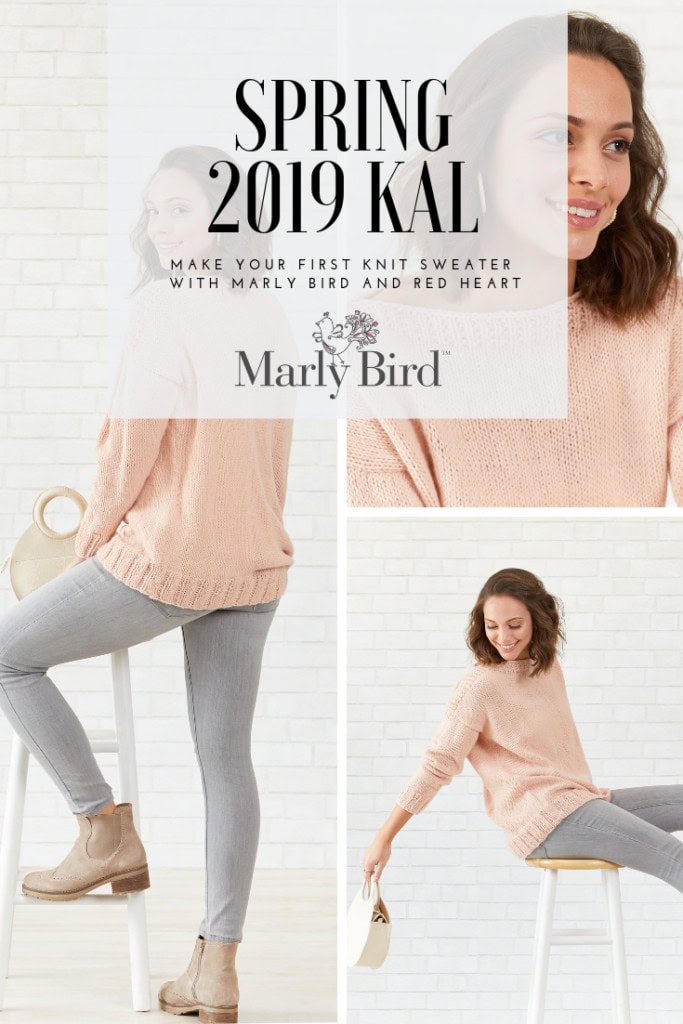My First Knit Sweater Knit-along Week 1 is the start of the annual knit together hosted and designed by Marly Bird, sponsored by Red Heart Yarns. Join the fun at any time. Click here to find out all the details and the instructions for weeks 1-6.

Video for Week 1
Follow along as you sit in on your first weeks lesson for the My First Knit Sweater Knit-along with Marly Bird. Remember, these KAL’s are like taking a class with Marly!
Choosing the right size for YOU
The My First Knit Sweater by Marly Bird is designed to be oversized (10+ ease). That means that if you have a bust size of 34”, then the sweater will be 44”. Ease is just a term for the amount of room you have between your body and the sweater.
Take a look at the sweater on the model. She has a bust of 34″ or a size Medium. She is wearing the 44″ or size medium sweater. You’re able to see how much room she has to comfortably wear this sweater.

To choose the best size for you, you can either go solely with the to fit size, or take a look at the finished sizes of the sweater and choose the finished size you like best. Either way, you want to make a sweater that is BEST FOR YOU!
The measurements for this sweater pattern are below.
To Fit Size: Small, (Medium, Large, 1X, 2X, 3X, 4X)
Finished Size: Bust: 39 (44, 49, 54, 59, 64, 69)” / 99 (112, 124.5, 137, 150, 162.5, 175.5) cm
Length: 24.75 (25.5, 26.25, 27, 27.75, 28.5, 29.25)” / 63 (64.5, 66.5, 68.5, 70.5, 72.5, 74.5) cm
Once you have chosen the to fit size that is best for you, highlight the coordinating finished size or vice versa. You are highlighting both numbers so you are always aware of the position of the number outside or within the parenthesis that pertains to your size.
When we get to the pattern, you will also highlight the number outside or within the parenthesis that pertains to your size so you follow the correct number throughout the pattern.
Now that we know what size we want to make it is time for use to tackle the yarn and needle choice.

Yarn (fiber, weight, texture what is important?)
When making a sweater, half the fun is picking the yarn you will use for that sweater. Take a look at a yarn wall and you will see that the possibilities are endless! But where do you start?
Let’s begin with the basic yarn information. Yarn is made up of strands of fiber twisted together to form yarn. This fiber can be animal, plant, or cellulose based. I’ve seen yarn made from Buffalo, Yak, Wool, Cotton, Bamboo, and Plastic. Each fiber behaves differently and has different characteristics. It is important that you are aware of their tendencies before choosing yarn for your project.
Wool:
- Typically comes from sheep
- Flame resistant
- Weaker than cotton or linen, especially when wet
- Springs back into shape after being crushed
- An excellent insulator as woolens (80% air)
- Absorbs moisture which is held inside the fiber (the wool will still feel dry even on a humid day)
- Accepts dyes easily (“dyed in the wool”)
- Quality of wool varies with the breed of sheep
- Does not attract dirt or static electricity
Cotton:
- Made from the cotton boll
- Absorbs water and “breathes”
- Slow to dry
- Has no memory and will not bounce back into shape once stretched
- Can withstand heat, detergents, and bleach about 20% stronger when wet than dry
- Will shrink unless treated
- Can be damaged by mildew
- Can be damaged by prolonged exposure to sunlight
Acrylic:
- Resists abrasion (but can “pill”)
- Have memory and is very resilient (springs back into shape)
- Easy to wash and wear
- Does not absorb water (can be uncomfortable when worn next to the skin in warm weather unless loosely woven)
- Dries quickly
- Attracts static electricity which also attracts dirt and lint
- Although they do NOT absorb water, they DO absorb oil and grease. This means synthetics
- resist soiling, but once an oil-based stain soaks in, it can be difficult to clean.
- Lightweight and fairly strong
- Acrylic can bulk to look like wool
- Drapes well
What this all means is you want to make sure if you are making a hip length sweater for yourself, you want to use a fiber that will hold the shape and weight of the garment and not end up looking like a wedding dress.
But choosing the right fiber is only the start to choosing the right yarn. You must also consider the size or weight of the yarn. The size or weight of the yarn is determined by the diameter of the yarn. These weights include lace weight yarn, fingering weight yarn, sport weight yarn, worsted weight yarn, bulky weight yarn, and super bulky weight yarn.
Don’t worry, you don’t have to memorize them. The Craft Yarn Council (CYC) has made it easy for us knitters to know the weights of yarn by assigning labels to them. We now have a standard to go by. When you are at the store or online looking at the different yarns, look for the CYC symbol indicating what weight the yarn is you’re looking to buy.
‼️But beware that even though two yarns might be a size 4 they could knit up drastically different because of the fiber, the spin of the yarn, or one might be slightly larger than another‼️
Pro Tip: When buying yarn for a project, always check the dye lots of the yarn to make sure you have the same colors, and always buy enough yarn to make the entire project. Nothing worse than running out of yarn when you are nearly done with a project! I will always buy at least 1 more ball of yarn than what I think I need just to make sure I have enough yarn for the project and for the gauge swatch.
The My First Sweater by Marly Bird used Red Heart’s Hygge Charm, a mostly acrylic yarn that is very lightly spun and is made up of 7 strands of fiber. It doesn’t have a lot of bounce or spring off the ball and is relatively smooth. It also comes in 7oz balls / 198 g balls = 432 yds / 395 m. Now, that is a LOT more information that you will find on a typical pattern but that is why you all are here doing the knit-along with me. Because I am here to give you that information. 🙂 Now, take that highlighter back out and highlight the number of balls of yarn you will need for your sweater.
It is recommended that you use the same yarn for this knit-along but I know that some of you are like me and want to use what YOU want to use, and that is okay. I do want you to make an educated choice when you select a different yarn. Make sure that you at least get a yarn that is the same weight as the Hygge Charm, you buy enough yarn (calculate how many balls of yarn you need for the size you’re making and multiply that by 432 yds. That will tell you how many yards of yarn you need to buy), and most importantly follow through with all of the instructions and complete a gauge swatch.
Needles & Gauge
All patterns list a suggested yarn (or at least a suggested weight of yarn) and the amount needed of the yarn, followed by the suggested needle size.
Did you read that? SUGGESTED NEEDLE SIZE!
If you have never read that before, you are not alone. It is surprising to me how many knitters (and crocheters) do not know that the needles size on a pattern (or a ball band) are only suggested numbers. These numbers do not mean that only that size needle can be used on that pattern or with that yarn.
The needle size given on the pattern is what the designer used to get the listed gauge. That does not mean that you must use that same needle size for your pattern; it only means that the designer is giving you a place to start when choosing the correct needle size for YOU to use in order for YOU to get the same gauge as he/she got.
You can use any brand or type of needle you wish. They can be metal, wood, bamboo, or acrylic. It doesn’t matter. What does matter is that you choose a needle size that you are able to get gauge.
Once you’ve chosen the yarn for your sweater, you need to start sampling out needle sizes for that yarn by doing a gauge swatch. The suggested needle size for this sweater is below.
Needles: 5.5 mm [US 9]
Now it’s time to talk about gauge.
You can knit for years without worrying about gauge, but as you expand your skills and really fine-tune your technique, you will want to follow patterns and recreate those items in both style and size. That is where the term gauge because very important.
Every knitted fabric is made up of stitches and rows. Gauge is the number of stitches and rows it takes to make 1 square inch or one full repeat of knitted fabric. In any pattern you will find the gauge the designer used to make that item. And as long as you get the same number of stitches and the same number of rows to equal the same measurement as written in the pattern then you are sure to get the same size as the designer intended.
Gauge isn’t always important, such as when you’re making a scarf, an afghan, a bag, or anything else for which a precise size isn’t essential. But when size does matter, as in when you are knitting a sweater, the right or wrong gauge can make or break the finished piece. The gauge for the sweater knit-along is below.
Gauge: 16 sts = 4 ” (10 cm); 22 rows = 4” (10 cm) in St st. CHECK YOUR GAUGE. Use any size needles to obtain the gauge.
Things that affect gauge include the fiber of the yarn, the yarn weight, the tension of the knitter (are you stressed or relaxed), and the knitting needle size. A stitch is made by wrapping yarn around the needle, therefore, the size (circumference) of the needle determines the size of the stitch. That is why it is important that you do what is called a gauge swatch with yarn and needles to find the same gauge as listed in the pattern.
Repeat after me, GAUGE IS NOT A STANDARD! I’ve had so many knitters tell me, “I knit to gauge, I don’t need to do a swatch.” Do you know what I have to say to that? Hogwash!!! GAUGE IS NOT A STANDARD, it is dependent on the way an individual knitter knits with the yarn and the needles of choice. Therefore, it is crucial to do a gauge swatch with the same yarn and needles you plan on using for your sweater to find out what size needles you need to use.

Gauge Swatch
Just as it is important to use the same needle you plan on using for your project, It is important that you use the same yarn for your gauge swatch as for your project, not the same brand in a different color. Different dyes can affect how a specific yarn knits up, and believe it or not, a yarn in one color can give you a different gauge from the same yarn in a different color.
To make your swatch for the My First Knit Sweater by Marly Bird, follow these instructions.
Cast on 33 sts.
Row 1 (WS): P3, *k2, p3; repeat from * to end.
Row 2 (RS): K3, *p2, k3; repeat from * to end.
Repeat rows 1 and 2 another two times, then row 1 once.
Row 8 (RS): Knit
Row 9 (WS): Purl
Repeat rows 8 and 9 until piece measures approx 6” ending after a RS row.
Next Row (WS): P1, *k1, p1; repeat from * to end.
Next Row (RS): Knit
Repeat the last to rows two times, then row 1 once.
Bind off
Measure Gauge Swatch
Time to measure the swatch for what is called the pre-blocked measurement. You need this measurement because you will want to compare the pre-blocked gauge to the post-blocked gauge to see if there is a difference.
To measure your swatch, smooth it out on a flat surface. Pin the edges down if they’re curling in — be careful not to stretch your swatch — and follow these steps:
- Lay a ruler along a row of stitches and mark the beginning and end of 4 inches with straight pins.
- Note the number of stitches or stitch pattern repeats in 4 inches, fractions and all.
- Lay your ruler along a vertical line of stitches, aligning the bottom of the ruler with the bottom of a stitch, and put a straight pin in to show where the first stitch begins. Place another straight pin 4 inches up.
- Count the rows between the pins, fractions and all, and note the number of rows.
You now know the number of stitches, as well as row you get with that yarn and that needle over 4”. Write that number down.
Check to see if those measurements are the same as what the pattern indicates you need. If it is spot on, lucky you!
If it is off, here is what you do. If the stitches are too many, then your stitches are too small and you need to go up a needle size. If the stitches are too few, then your stitches are too big and you need to go down a needle size. Easy as that.
However, you are not done yet. We want to make sure that our fabric will stay the same size after we wash it. So we need to do a wash and block of the swatch.
Wash & Block Swatch
For any finished item that you plan on washing at some point, you want to actually wash the swatch. Treat the swatch as you would the finished item. Use soap, put it in the washer (if it is machine washable) and let it dry. Doing so will help you see how the fabric will behave after washing.
Does it hold together? Does it pill? Does it stretch? Does it get fuzzy? All of these things are important to know before you spend your time using that yarn to make a full size item.
Finding out these things before you have a finished sweater that you can’t wear is the benefit of washing your swatch. But what about the blocking part?
First, did you know that the given gauge in a pattern is the blocked gauge (unless noted differently)? That means, it is entirely possible to have a pre-blocked gauge of 18 sts = 4” but after blocking the measurement can increase to 14 stitches = 4”! Over the course of a full project that is a HUGE difference. Therefore, it is imperative that you know what the blocked gauge is of your swatch.
Now, for the most part, wet blocking acrylic yarn doesn’t really do anything to change it, but when you are using a wool, like Chic Sheep by Marly Bird™, blocking is very important. Specifically, I suggest wet blocking.
Because this beginner sweater knit-along is like taking a class with me, I think it is important that I tell you how you would wash a block wool or any animal or plant fiber.
Just as I mentioned above, you want to wash your swatch. I suggest hand washing the finished swatch in your sink and use a wool wash. When you do this you are giving that yarn a spa treatment. The yarn has been handled, tugged, pulled, knitted and really just needs a chance to relax and let the fibers settle into place. Not only will the yarn really show its true beauty when cleaned but it will block even more beautifully.
After the swatch has had good wash, follow these steps to block it out.
- Get as much water out of your swatch as you can without stretching or wringing it out. NOTE: When you lift the piece out of the sink, lift it out in both hands, making sure not to let any part of it stretch down.
- Without stretching the piece, spread it out on the towel and fold the ends of the towel over it; then gently and loosely roll up the towel to absorb more water.
- Gently lay your piece out on the blocking board.
- Here is a tip, I like to use the cardboard cutting boards from the fabric section of the big box store. The grid lines on the board make it easy to measure out and block my swatch or my finished piece. NOTE: before you use it, be sure to use a damp paper towel and wipe it down to get rid of any extra ink!
- Spread your piece out the measurements of the piece as a guide.
- Using straight pins, pin and smooth all pieces.
- Allow the piece to air dry. Keep the piece out of the sun as that may cause discoloration. If you’re in a hurry, you can get your piece to dry in a matter of hours by placing a fan in front of it.
The last thing to do after the swatch has been blocked is to unpin it from the blocking board, let it rest for a couple minutes then measure it for gauge.
Just as before, measure the swatch to see if it meets the same gauge as in the pattern. Make sure you write down your post block measurement as well.
Yes….I can hear you all groaning! Buck up Buttercup. My guess is that many of you are here because you have a desire to learn how to knit a sweater but you also want a sweater that will fit. Well, we need to make sure that our prepwork is complete before we can jump into the knitting to have a better chance of making that desire a reality.
So, to recap your homework for week 1 of the My First Knit Sweater by Marly Bird Knit-along is this:
- Choose the size you want to make
- Highlight the size on the pattern
- Choose the yarn you want to use
- Choose the needles you want to swatch with first (remember, you will use these needles for the sweater so make sure they are long enough for the project)
- Do a gauge swatch
- Measure the gauge swatch (pre-blocked measurement)
- Wash and block the gauge swatch if it isn’t acrylic (or if you just want to see how your acrylic swatch will look)
- Measure the gauge swatch again (post-blocked measurement).
One last thing. I do not want you to take your swatch apart when you are done with it. I want you to put it aside and keep it throughout this entire knit-along. Trust me on this.
Okay, let’s do this and then we will be ready to have fun knitting our first sweater! Click here to go back to home base and get the next set of instructions.

GIVEAWAYS
Post your progress pictures each week in the Marly Bird KAL Facebook group to be entered for a chance to win a Red Heart prize pack! We’ll choose one winner each week for the prize pack. One week after the final video is posted we’ll ask you to share a photo of your finished sweater, and we’ll choose 3 winners to each win a $50 prize pack from everyone who finished.
To enter: Post your picture of your in-progress sweater in the Facebook group before Tuesday at 11:59pm Mountain Time (Marly’s time zone) to be entered. Winners will be announced on Thursdays.
Week 1: Post your progress picture by Tuesday, April 9; 1 winner of a $25 prize pack announced Thursday, April 11
Week 2: Post your progress picture by Tuesday, April 16; 1 winner of a $25 prize pack announced Thursday, April 18
Week 3: Post your progress picture by Tuesday, April 23; 1 winner of a $25 prize pack announced Thursday, April 25
Week 4: Post your progress picture by Tuesday, April 30; 1 winner of a $25 prize pack announced Thursday, May 2
Week 5: Post your progress picture by Tuesday, May 7; 1 winner of a $25 prize pack announced Thursday, May 9
Week 6: Post a photo of your completed sweater by Tuesday, May 14; 3 winners of $50 prize packs announced Thursday, May 16
